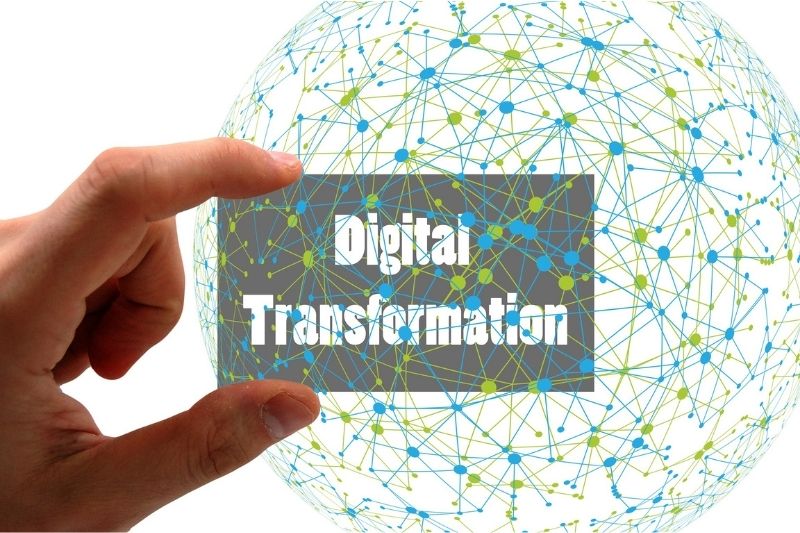No products in the cart.
How Education Field is Affected by Digital Transformation

Technology has been instrumental in the education sector for quite some time, and an unfortunate pandemic known as COVID-19 is pushing these innovations even further.
With a sudden increase of students needing to study more at home due to their illness or lack of access to schools, virtual tutoring with platforms like Zoom is becoming increasingly more popular.
The new technologies have made it easier for teachers and professors who work remotely without any physical contact whatsoever; they can now easily share content from anywhere on earth.
The digital transformation in education is gathering more speed as students turn toward these online platforms for their learning needs.
In this blog post, we’re going to look at some of the important ways that emerging technologies have affected this important market in recent times.
Artificial Intelligence In Education
One huge aspect of Digital Transformation is the use of AI.
With the new advancements of artificial intelligence, there has been a growing number of educational software that uses it to deliver their content.
Brenton Way has written a fascinating article on how AI is re-shaping the way they look at digital marketing. This article gives a broad overview of how AI works and should also give a better idea of how to apply it in education.
The AI-based learning platforms provide more personalized and interactive solutions compared to other course builders.
The personalization aspect is achieved by analyzing the students’ behavior and providing relevant suggestions on how they can do better in the class.
The AI-based learning platforms also offer a wide range of courses such as business, marketing, computer science and management.
Casestudies
90% accuracy was achieved for predicting student outcomes for an educational institute.
https://gleetech.com/wp-content/uploads/2019/03/case-study-education_mod.pdf
Ivy Tech develops machine learning algorithm to identify at-risk students and provide early intervention
https://edu.google.com/why-google/case-studies/ivytech-gcp/
Artificial intelligence for education: Knowledge and its assessment in AI-enabled learning ecologies
https://www.tandfonline.com/doi/abs/10.1080/00131857.2020.1728732?journalCode=rept20
Real World Examples of How AI is Used In Education
AI is not a future pipedream; it’s a reality. In education , AI is being used in a number of real-world applications at the moment.
For instance, students from low income families are able to attend schools that would have otherwise not been affordable thanks to AI-based financing.
The AI platform can identify students who are having trouble paying for their school fees and provide them with soft loans for college – all without the need for a human intermediary.
Education tools powered by artificial intelligence are also being used in classrooms to help both teachers and students.
AI-based speech recognition makes it easier for students with hearing impairments to learn, because they can get access to instant transcriptions of teacher’s lectures, as well as their own, without the need for pen and paper.
Here are four more examples of how AI is beeing used at schools:
- UpSkill: This platform uses AI to generate customized study material for students, based on their prior knowledge and interests.
- Edureka: The personalization aspect is achieved by analyzing the student’s behavior using machine learning tools and providing relevant teaching sessions or suggestions on how to improve their grades.
- Pluralsight: The communication between students and the teachers is greatly enhanced by using AI to generate transcriptions of their lectures.
- Botangle: This platform offers courses designed exclusively for foreign students studying in English, such as Spanish learners who want to improve their English skills.
All these platforms provide extra features through AIs algorithms that can be used to to make the student’s experience as smooth and pleasant as possible.
Gamified Learning: Incentivizing Students
As online games have gone to newer levels in today’s digital age, many educational apps are offering gamification features to get students more involved in their study material. It is easier for the developers to incorporate gamification features into their platforms because of the interaction between AI-based learning systems and its users.
The way that it works is by observing your behavior and taking note of what you’re struggling with most. The AI would suggest online courses or other forms of study material for you to use while offering a reward at the same time. The reward is often an achievement or a badge that rewards you for your effort.
Assessing and Addressing Students’ Skills and Weaknesses
AI is being used to assess students’ skills and then suggest how they can improve.
An AI based learning platform called Dreambox has recently developed an algorithm that is capable of detecting any error in a student’s written English, and recommending self-correcting exercises to help them overcome their weaknesses.
Other platforms like Yes Ed offers personalized feedback on all of their students’ written assignments.
Although most assessments are still done by humans, these new technologies can be quite useful to both teachers and learners in the future.
Empowering Students with Crowdsourced Learning
Nowadays, students can learn a lot from their peers thanks to new technologies.
A platform called Kudoz, which was developed by IBM’s Watson , is able to extract expert answers from user-generated question and answer (Q&A) content on the web.
For example, if a math student needs help, he can ask a question, and the AI-based platform will provide relevant answers from the crowd.
These new technologies also help students to be more independent learners, because they no longer need to wait for their teacher’s response.
Creating Customized Learning Materials
The great thing about AI is that it can help create customized educational material or solutions to meet the needs of different students.
By using machine-learning algorithms, IBM has created an AI platform called EntryPoint that enables teachers to find and utilize resources from millions of online sources in their own unique way, without having to search for them manually.
A platform called ChatbotPlaybook is used to automatically create characters and dialogues for AI-powered chatbots, which can then be used in classes to answer questions on a subject matter within a few seconds.
These new technologies can help both students and teachers because they make it easy to find the right content or solutions needed, without having to spend hours searching for them.
Decreasing Time Spent Grading Assignments
AI is also being used to grade assignments and assess students’ learning performance.
A tool called Viki uses a natural language processing (NLP) algorithm to scan essay papers for possible plagiarism, such as copying sentences from the internet without citing sources or copy-paste content from google docs.
This technology can be quite useful for students who want to minimize the time spent on grading and focus more on teaching.
Changing the Way We Interact with Information
While we used to rely mostly on physical books and papers to gather information, the current shift to digital transformation has changed our methods.
Students are now turning towards online platforms like Blackboard or Moodle for their study needs.
The concept of e-learning seems to be catching up with professors and students worldwide; they can watch a video lecture from their phone, tablet or computer, and even introduce a new element to the traditional lecture with synchronous online group discussions.
The change in learning methods will have other effects on education as well; for instance, it will also eliminate some of the negative consequences that accompany traditional book-based learning, such as an increased carbon footprint or a greater need to store materials.
Students are now mostly studying at home, taking advantage of modern technology to get the information they need.
They can easily share files with their instructors through cloud-based file-sharing services so that anyone can access them and comment on them.
Many students prefer e-books for their studies because it’s cheaper both in time and money.
Digital Transformation is Impacting How Teachers Teach and How Students Learn
Teaching used to be a fairly static affair, with students sitting in a classroom listening to what the teacher says and learning from it.
Teachers have had to adapt to the new digital world, and they’ve had to make sure that their methods of teaching align with all the different ways that students can learn.
The digitization of education has given teachers far more freedom in how they deliver content to students; online discussions are much easier for them because they have a wider audience and thus they can engage with more people.
They’ve also had to make sure that they don’t simply repeat what a book says but rather expand on it; students learn through many different methods and are not always interested in textbooks.
The rise of social media has made teachers more accessible for students who can now quickly get answers to the questions they have.
Students are now able to watch a lecture or read some material and then take a quiz on the same material for immediate feedback, encouraging them to study harder and longer.
The new technologies have also made sure that students can continue their education even if they’re far away from schools.
Educational Institutions are Embracing Change
With the sudden rise in technology, many schools have had to change how they teach their students.
This has lead to schools making changes in curriculum and teaching methods, but it has also changed student life. Take for example, here, where you can see how companies are actually making teaching methods more successful through technological innovation.
Student engagement levels have also gone up as a result of these changes.
Students can now enjoy an enriched, personalized, and relevant learning experience.
Traditional lecture-based classes still exist but students are encouraged to explore other methods like e-books or on-demand video lectures.
This style of learning can be more time-consuming, but it’s also much more interesting for the students and can be tailored towards their own unique needs.
Students aren’t looking for a one-size-fits-all approach; they want to learn in different ways and at their own pace.
This is why on-demand learning has become so popular; students are able to easily choose the learning methods they enjoy and then proceed at their own pace.
The flexibility of digital transformation has allowed for a wider range of teaching methods and styles that can be tailored to each person’s unique learning needs but still offer more personalized experiences than traditional lecturing ever could.
Teachers are Becoming More Specialized
As teachers, their field becomes more complicated due to technological advances.
Some teachers are choosing to specialize in one particular subject and then expand on the traditional textbook material.
They have a wide array of tools at their disposal that allows them to look up information more easily, including online encyclopedias and multimedia presentations.
The newest technology has even allowed for virtual teachers who can deliver lessons from different cities or even countries.
Many teachers are now able to get a broad and rich education that is much more direct and valuable than when they were taught in classrooms with many students.
The rise of digital transformation have allowed educators to become more specialized in their own field of study; they are better prepared for what they’re going to face when they enter the workforce.
They are able to learn more and get a more comprehensive education than their teachers ever could.
This specialized learning also allows educators to guide students who need help on certain topics into new areas of study that they might be interested in but had previously not known about.
The hands-on experience and personalized services allow students the freedom to become more passionate about their studies and choose a specialization they enjoy.
Students are given a new world of knowledge at their fingertips where they can learn on their own time, in their own way, and without any limitations.
How are Schools Re-thinking Their Models
Digital transformation has given students and teachers the power to learn together, but it’s also forcing schools to re-think their pedagogical models to keep up with technology. For example, healthcare education was previously a very traditional program with labs and in-person classes. However, not only has the field become far more digitally oriented, it’s opened up a host of careers for digital and distance certification. Jobs that would have required years in an associate’s degree at a community college are now online and in a quick duration. Medical assisting is a great example. These health professionals support nurses and doctors in front-line care. Students can now find a medical assistant program or training school that is completely online and digitally transformed. It’s opened up the opportunity to countless people.
It’s important for educators to teach in a way that is accessible to their students.
They need to understand what their student-base needs from them, which can vary greatly between schools or even within one school.
Digital transformation has given rise to a new kind of teacher that is willing and able to adapt the ways they teach in order to better cater towards their specific student base.
They are constantly making changes to the curriculum, teaching styles, and other areas in order to provide students with the best possible learning experience.
How Do Schools Help Their Students Learn New Skills?
Digital transformation has allowed schools to rethink how and when students learn new skills.
Some schools have seen a rise in competency-based models that align closely with the 21st-century workplace and allow students to progress at their own pace while still graduating at a similar time as everyone else.
This allows them to take advantage of digital learning tools, such as videos or interactive simulations, which would normally not be available to them.
Schools have also seen a rise in independent learning, which allows students the freedom to study on their own time and at their own pace while still receiving credit for what they learn.
This new flexibility allows students to spend more time practicing skills that they are having difficulties with and would otherwise waste time on material they are already strong in.
Digital transformation has allowed schools to rethink how their students learn new skills, which can now be done seamlessly and more efficiently through online classes or independent projects.
What New Skills Are They Teaching Students?
Digital transformation has also led to the creation of many new kinds of jobs.
Students are being exposed to skills and concepts that their teachers never had the opportunity to learn in schools, such as computer programming or robotics.
These new kinds of skill sets allow them to easily pick up these skills from online videos or projects, then use them on the job for work experience.
Employers now look at class projects and portfolios as a much more important part of the hiring process.
How To Prepare Students for a Future with Constant Technological Change
Digital transformation has taught students that it’s okay to make mistakes and mess up.
The traditional schooling system has been criticized for creating a society of people who are afraid of failure and don’t take enough risks.
This feeling of fear and lack of desire to experiment is exactly the opposite of what we need in a society that encourages innovation and exploration.
Digital transformation is helping to shift the way we teach our children in schools by allowing them to learn at their own pace, fail, and try again until they succeed.
This kind of freedom can provide students with an unending love for learning and the ability to take risks because they aren’t afraid of failure.
Teachers can be more effective teachers when they allow their students to experience new technologies for themselves.
They still need to provide a solid base knowledge and understanding of concepts, but by giving them the freedom to explore, they can make sure that nothing is missed.
This new kind of education model will allow students to learn in a way that clicks for them and allows them to gain skills faster than their peers. This is only possible through new technologies such as virtual tutoring or e-learning platforms.
Closing Thoughts: A New Kind of Education
Digital transformation is changing the way that students learn new skills and the kinds of skills they are learning.
Consumers have become much pickier about what they want from a product, so businesses need to keep upping their game in order to provide effective products.
In education, this means moving away from older teaching methods and embracing digital transformation to better suit the needs of students.
When they graduate, they’ll be ready for a job in today’s innovative world.
We hope this article was helpful and has given you more insights into how new technologies have change the landscape of Education.















Digital transformation is truly revolutionizing the education sector. This article highlights some key changes, like improved accessibility and personalized learning. It’s exciting to see how technology continues to shape the future of education!